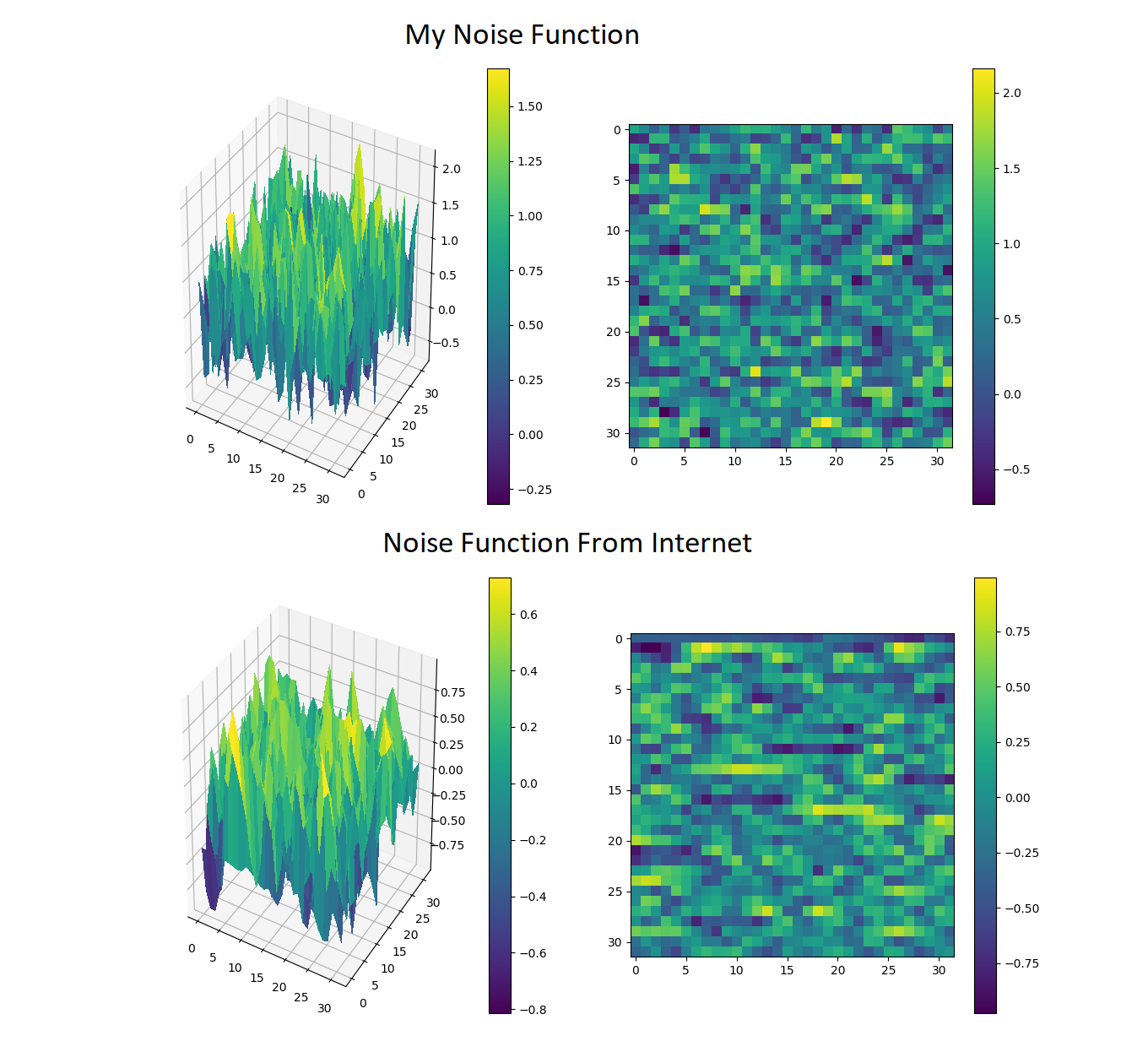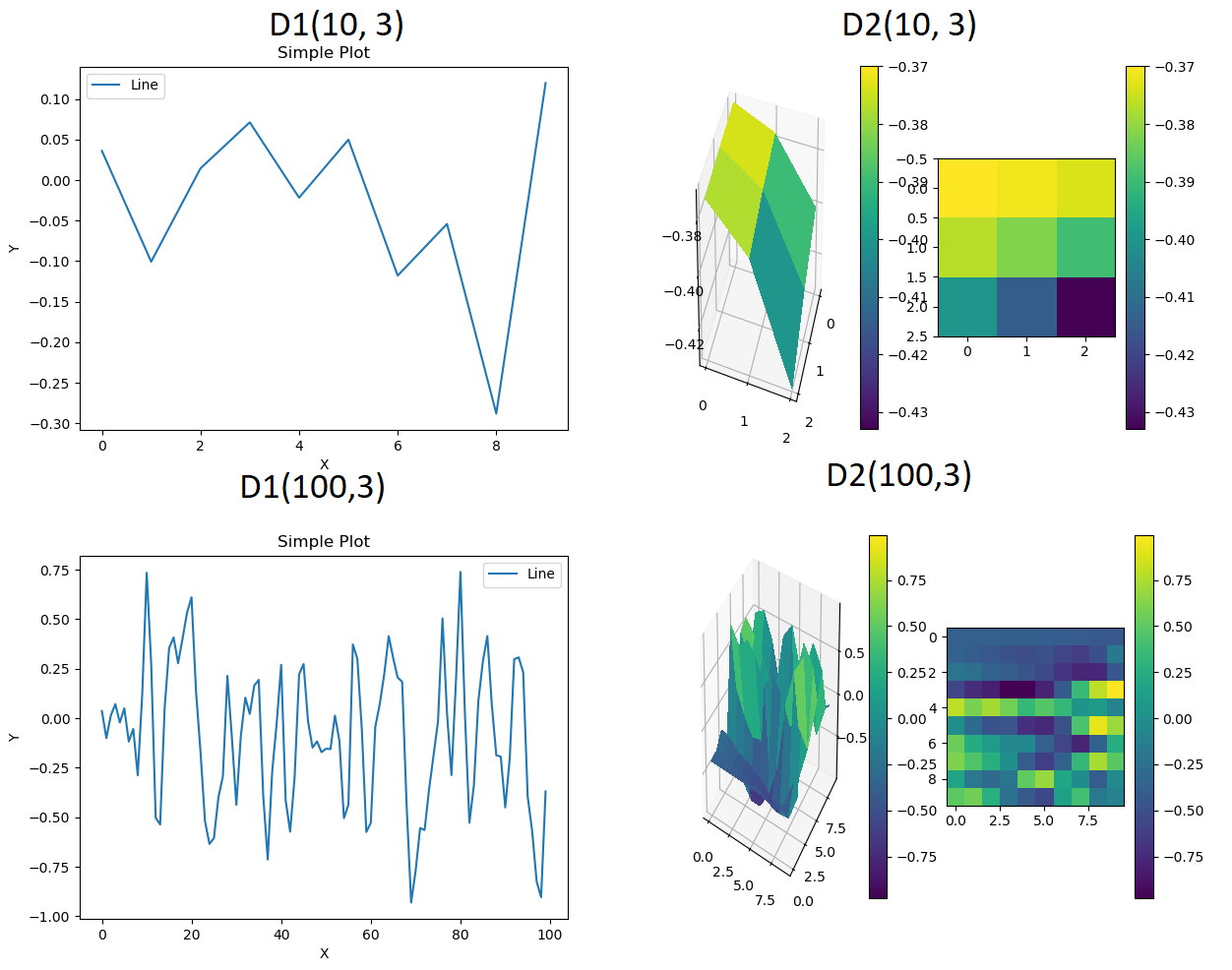我正在尝试使用 Perlin 噪声发生器来制作 map 的图 block ,但我注意到我的噪声太尖锐了,我的意思是,它有太多的高程,没有平坦的地方,而且它们看起来不像像山脉、岛屿、湖泊或任何东西;它们看起来过于随机并且有很多峰值。
在问题的末尾,需要进行更改才能修复它。
问题的重要代码是:
一维:
def Noise(self, x): # I wrote this noise function but it seems too random
random.seed(x)
number = random.random()
if number < 0.5:
final = 0 - number * 2
elif number > 0.5:
final = number * 2
return final
def Noise(self, x): # I found this noise function on the internet
x = (x<<13) ^ x
return ( 1.0 - ( (x * (x * x * 15731 + 789221) + 1376312589) & 0x7fffffff) / 1073741824.0)
二维:
def Noise(self, x, y): # I wrote this noise function but it seems too random
n = x + y
random.seed(n)
number = random.random()
if number < 0.5:
final = 0 - number * 2
elif number > 0.5:
final = number * 2
return final
def Noise(self, x, y): # I found this noise function on the internet
n = x + y * 57
n = (n<<13) ^ n
return ( 1.0 - ( (x * (x * x * 15731 + 789221) + 1376312589) & 0x7fffffff) / 1073741824.0)
我在代码中留下了 1D 和 2D Perlin 噪声,因为也许有人对此感兴趣:
(我花了很长时间才找到一些代码,所以我想有人会很乐意在这里找到一个例子)。
您不需要 Matplotlib 或 NumPy 来制造噪音;我只是用它们来制作图表并更好地查看结果。
import random
import matplotlib.pyplot as plt # To make graphs
from mpl_toolkits.mplot3d import Axes3D # To make 3D graphs
import numpy as np # To make graphs
class D(): # Base of classes D1 and D2
def Cubic_Interpolate(self, v0, v1, v2, v3, x):
P = (v3 - v2) - (v0 - v1)
Q = (v0 - v1) - P
R = v2 - v0
S = v1
return P * x**3 + Q * x**2 + R * x + S
class D1(D):
def __init__(self, lenght, octaves):
self.result = self.Perlin(lenght, octaves)
def Noise(self, x): # I wrote this noise function but it seems too random
random.seed(x)
number = random.random()
if number < 0.5:
final = 0 - number * 2
elif number > 0.5:
final = number * 2
return final
def Noise(self, x): # I found this noise function on the internet
x = (x<<13) ^ x
return ( 1.0 - ( (x * (x * x * 15731 + 789221) + 1376312589) & 0x7fffffff) / 1073741824.0)
def Perlin(self, lenght, octaves):
result = []
for x in range(lenght):
value = 0
for y in range(octaves):
frequency = 2 ** y
amplitude = 0.25 ** y
value += self.Interpolate_Noise(x * frequency) * amplitude
result.append(value)
print(f"{x} / {lenght} ({x/lenght*100:.2f}%): {round(x/lenght*10) * '#'} {(10-round(x/lenght*10)) * ' '}. Remaining {lenght-x}.") # I don't use `os.system('cls')` because it slow down the code.
return result
def Smooth_Noise(self, x):
return self.Noise(x) / 2 + self.Noise(x-1) / 4 + self.Noise(x+1) / 4
def Interpolate_Noise(self, x):
round_x = round(x)
frac_x = x - round_x
v0 = self.Smooth_Noise(round_x - 1)
v1 = self.Smooth_Noise(round_x)
v2 = self.Smooth_Noise(round_x + 1)
v3 = self.Smooth_Noise(round_x + 2)
return self.Cubic_Interpolate(v0, v1, v2, v3, frac_x)
def graph(self, *args):
plt.plot(np.array(self.result), '-', label = "Line")
for x in args:
plt.axhline(y=x, color='r', linestyle='-')
plt.xlabel('X')
plt.ylabel('Y')
plt.title("Simple Plot")
plt.legend()
plt.show()
class D2(D):
def __init__(self, lenght, octaves = 1):
self.lenght_axes = round(lenght ** 0.5)
self.lenght = self.lenght_axes ** 2
self.result = self.Perlin(self.lenght, octaves)
def Noise(self, x, y): # I wrote this noise function but it seems too random
n = x + y
random.seed(n)
number = random.random()
if number < 0.5:
final = 0 - number * 2
elif number > 0.5:
final = number * 2
return final
def Noise(self, x, y): # I found this noise function on the internet
n = x + y * 57
n = (n<<13) ^ n
return ( 1.0 - ( (x * (x * x * 15731 + 789221) + 1376312589) & 0x7fffffff) / 1073741824.0)
def Smooth_Noise(self, x, y):
corners = (self.Noise(x - 1, y - 1) + self.Noise(x + 1, y - 1) + self.Noise(x - 1, y + 1) + self.Noise(x + 1, y + 1) ) / 16
sides = (self.Noise(x - 1, y) + self.Noise(x + 1, y) + self.Noise(x, y - 1) + self.Noise(x, y + 1) ) / 8
center = self.Noise(x, y) / 4
return corners + sides + center
def Interpolate_Noise(self, x, y):
round_x = round(x)
frac_x = x - round_x
round_y = round(y)
frac_y = y - round_y
v11 = self.Smooth_Noise(round_x - 1, round_y - 1)
v12 = self.Smooth_Noise(round_x , round_y - 1)
v13 = self.Smooth_Noise(round_x + 1, round_y - 1)
v14 = self.Smooth_Noise(round_x + 2, round_y - 1)
i1 = self.Cubic_Interpolate(v11, v12, v13, v14, frac_x)
v21 = self.Smooth_Noise(round_x - 1, round_y)
v22 = self.Smooth_Noise(round_x , round_y)
v23 = self.Smooth_Noise(round_x + 1, round_y)
v24 = self.Smooth_Noise(round_x + 2, round_y)
i2 = self.Cubic_Interpolate(v21, v22, v23, v24, frac_x)
v31 = self.Smooth_Noise(round_x - 1, round_y + 1)
v32 = self.Smooth_Noise(round_x , round_y + 1)
v33 = self.Smooth_Noise(round_x + 1, round_y + 1)
v34 = self.Smooth_Noise(round_x + 2, round_y + 1)
i3 = self.Cubic_Interpolate(v31, v32, v33, v34, frac_x)
v41 = self.Smooth_Noise(round_x - 1, round_y + 2)
v42 = self.Smooth_Noise(round_x , round_y + 2)
v43 = self.Smooth_Noise(round_x + 1, round_y + 2)
v44 = self.Smooth_Noise(round_x + 2, round_y + 2)
i4 = self.Cubic_Interpolate(v41, v42, v43, v44, frac_x)
return self.Cubic_Interpolate(i1, i2, i3, i4, frac_y)
def Perlin(self, lenght, octaves):
result = []
for x in range(lenght):
value = 0
for y in range(octaves):
frequency = 2 ** y
amplitude = 0.25 ** y
value += self.Interpolate_Noise(x * frequency, x * frequency) * amplitude
result.append(value)
print(f"{x} / {lenght} ({x/lenght*100:.2f}%): {round(x/lenght*10) * '#'} {(10-round(x/lenght*10)) * ' '}. Remaining {lenght-x}.") # I don't use `os.system('cls')` because it slow down the code.
return result
def graph(self, color = 'viridis'):
# Other colors: https://matplotlib.org/examples/color/colormaps_reference.html
fig = plt.figure()
Z = np.array(self.result).reshape(self.lenght_axes, self.lenght_axes)
ax = fig.add_subplot(1, 2, 1, projection='3d')
X = np.arange(self.lenght_axes)
Y = np.arange(self.lenght_axes)
X, Y = np.meshgrid(X, Y)
d3 = ax.plot_surface(X, Y, Z, rstride=1, cstride=1, cmap=color, linewidth=0, antialiased=False)
fig.colorbar(d3)
ax = fig.add_subplot(1, 2, 2)
d2 = ax.imshow(Z, cmap=color, interpolation='none')
fig.colorbar(d2)
plt.show()
问题是输出似乎不适合 map 。
使用以下命令查看此输出:
test = D2(1000, 3)
test.graph()
我正在寻找更流畅的东西。
也许在 2D 噪声中很难注意到我在说什么,但在 1D 中就容易多了:
test = D1(1000, 3)
test.graph()
来自互联网的噪声函数的峰值略小且频率较低,但仍然太多。我正在寻找更流畅的东西。
P.S:我根据this pseudocode做了这个.
编辑:
皮卡莱克:
即使值很低,它也有峰值,没有曲线或平滑/平坦的线条。
geza:解决方案
感谢geza's suggestions我找到了解决问题的方法:
def Perlin(self, lenght_axes, octaves, zoom = 0.01, amplitude_base = 0.5):
result = []
for y in range(lenght_axes):
line = []
for x in range(lenght_axes):
value = 0
for o in range(octaves):
frequency = 2 ** o
amplitude = amplitude_base ** o
value += self.Interpolate_Noise(x * frequency * zoom, y * frequency * zoom) * amplitude
line.append(value)
result.append(line)
print(f"{y} / {lenght_axes} ({y/lenght_axes*100:.2f}%): {round(y/lenght_axes*20) * '#'} {(20-round(y/lenght_axes*20)) * ' '}. Remaining {lenght_axes-y}.")
return result
其他修改是:
Z = np.array(self.result)而不是这个Z = np.array(self.result).reshape(self.lenght_axes, self.lenght_axes)在图形函数中。- 在
Interpolate_Noise中使用math.floor()(记住import math)而不是round()在round_x和round_y变量中运行。 - 将
Noise(第二个)中的return行修改为return ( 1.0 - ( (n * (n * n * 15731 + 789221) + 1376312589) & 0x7fffffff)/1073741824.0)。D2(10000, 10) 现在唯一奇怪的是山脉(黄色)总是靠近同一个地方,但我认为这是改变
现在唯一奇怪的是山脉(黄色)总是靠近同一个地方,但我认为这是改变 Noise函数中的数字的问题。
最佳答案
我在您的代码中发现了这些错误:
- 您需要乘以
Interpolate_Noise参数,以“放大” map (例如,将x乘以0.01)。如果您在 1D 情况下执行此操作,您会发现生成的函数已经好得多了 - 将 Octave 数从 3 增加到更大(3 个 Octave 不会产生太多细节)
- 使用振幅 0.5^octave,而不是 0.25^octave(但你可以使用这个参数,所以 0.25 本质上并不坏,但它没有提供太多细节)
- 对于 2D 情况,您需要有 2 个外部循环(一个用于水平,一个用于垂直。当然,您仍然需要有 Octave 循环)。因此,您需要使用水平和垂直位置正确地“索引”噪声,而不仅仅是
x和x。 - 完全去除平滑。 Perlin 噪声不需要它。
- 2D 噪声函数有一个错误:它在返回表达式中使用
x而不是n - 在三次插值中,您使用
round而不是math.floor。
这是我的一个答案,带有类似 Perlin 的简单 (C++) 实现(它不是正确的 perlin)噪声:https://stackoverflow.com/a/45121786/8157187
关于python - 如何制作更平滑的 Perlin 噪声发生器?,我们在Stack Overflow上找到一个类似的问题: https://stackoverflow.com/questions/47837968/




